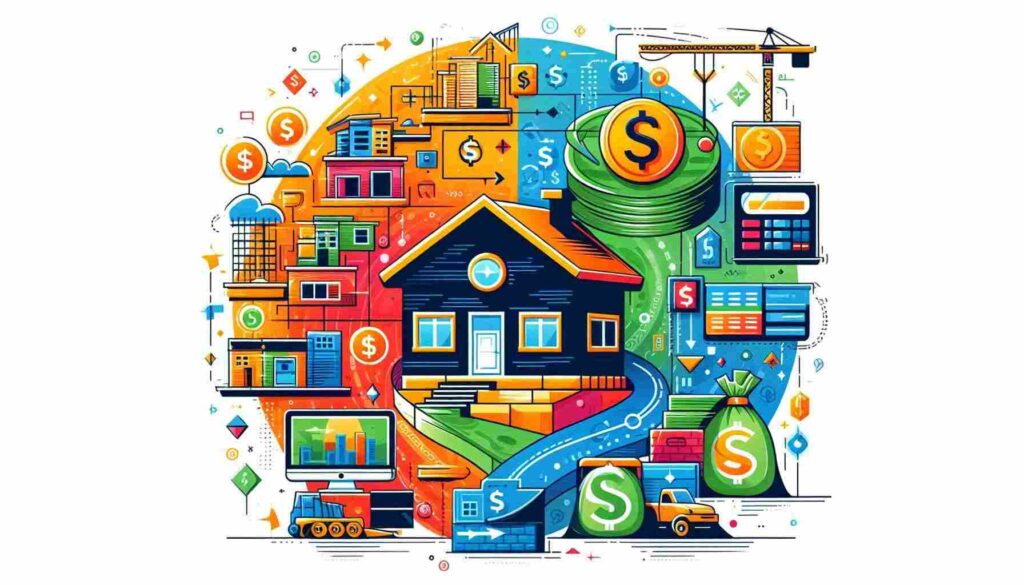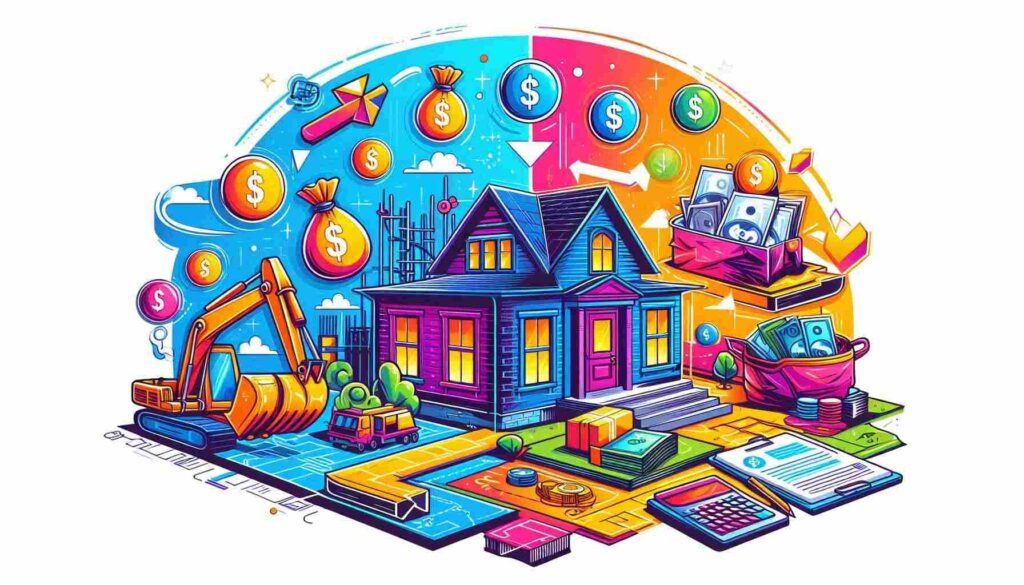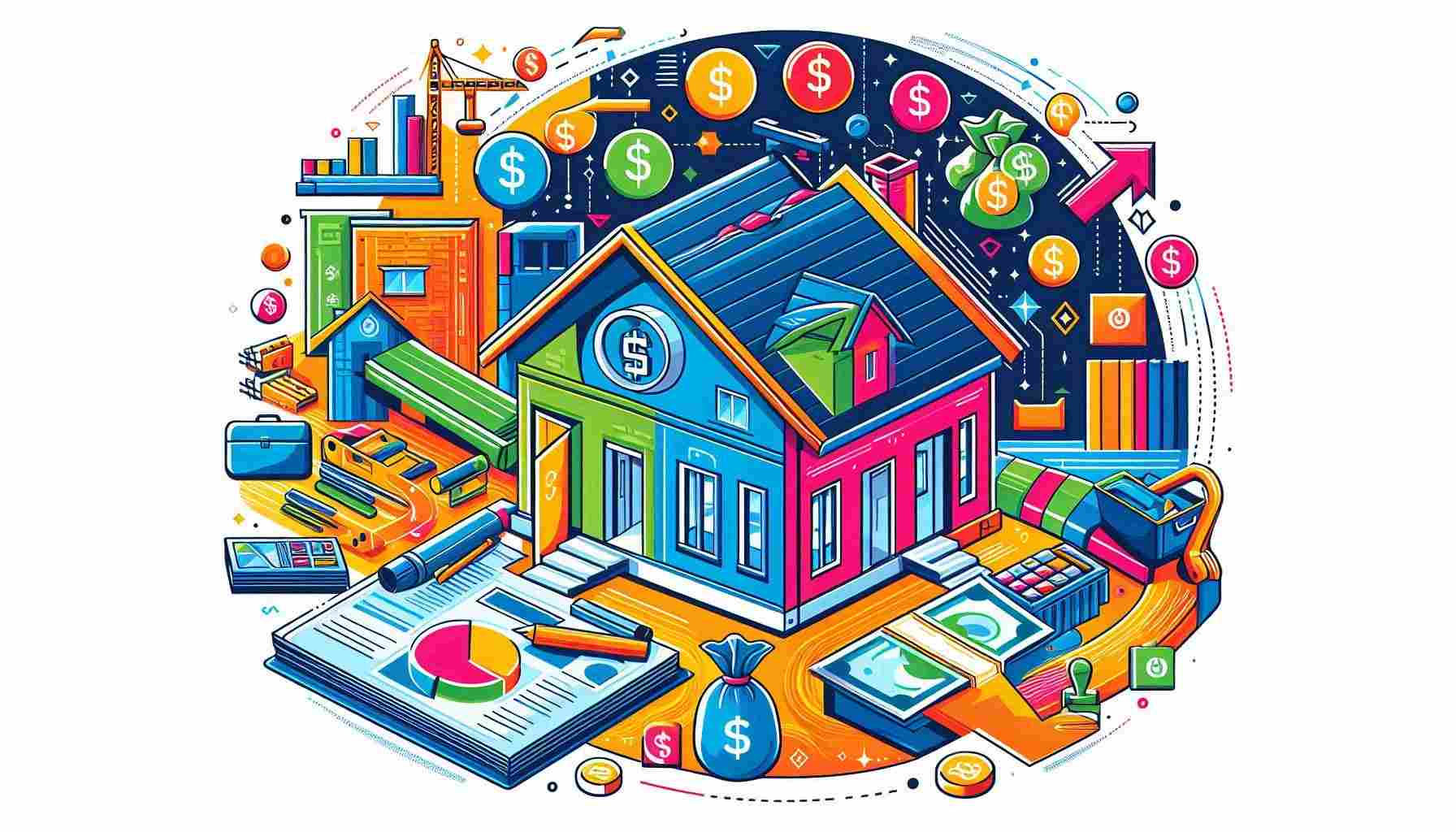Picture this: You’re finally ready to build your dream home, but the thought of juggling multiple loans makes your head spin. Enter the construction to permanent loan – your one-stop solution for financing your new build from foundation to finish. This nifty financial product is like having your cake and eating it too, combining the flexibility of a construction loan with the stability of a long-term mortgage.
Whether you’re a first-time homebuilder or a seasoned pro, understanding the ins and outs of construction to permanent loans can save you time, money, and a whole lot of headaches. So, let’s dive in and demystify this game-changing financing option!
Key Takeaways
- A construction to permanent loan is a single loan that covers both the construction phase and long-term mortgage for a new home build.
- It simplifies the financing process by eliminating the need for separate construction and mortgage loans.
- These loans typically offer flexible terms and can save borrowers money on closing costs.
- Understanding the loan structure and requirements is crucial for a smooth building and financing experience.

What is a Construction to Permanent Loan?
Alright, let’s break it down. A construction to permanent loan, also known as a C2P loan, is like the Swiss Army knife of home financing. It’s a clever little package that combines a short-term construction loan with a long-term mortgage, all wrapped up in one neat bow.
Here’s how it works: During the construction phase, you’ll typically make interest-only payments on the funds drawn to build your home. Once construction is complete and you’ve got your shiny new keys in hand, the loan automatically converts to a traditional mortgage. It’s like magic, but with less smoke and mirrors and more financial savvy.
The beauty of this loan type is that you only have to go through the approval process once, saving you time, paperwork, and potentially some serious cash on closing costs. Plus, you’ll have the peace of mind knowing your long-term financing is locked in from the get-go.
Benefits of Choosing a Construction to Permanent Loan
Now, you might be wondering, “Why should I choose a C2P loan over separate construction and mortgage loans?” Well, buckle up, because I’m about to drop some knowledge bombs that’ll make you wonder why you ever considered anything else.
First off, let’s talk convenience. With a C2P loan, you’re dealing with one lender, one set of paperwork, and one closing. It’s like ordering a combo meal instead of à la carte – you get everything you need in one tidy package.
Here are some more juicy benefits to sink your teeth into:
- Lower closing costs (because you’re only closing once)
- Potentially lower interest rates compared to standalone construction loans
- Predictable long-term payments locked in from the start
- Flexibility to choose from various mortgage options for the permanent phase
- Simplified budgeting and cash flow management during construction
But wait, there’s more! Many C2P loans offer interest-only payments during construction, which can be a real lifesaver if you’re still paying rent or a mortgage on your current home while building your new one. It’s like having a financial cushion to soften the blow of dual housing costs.

How Does a Construction to Permanent Loan Work?
Alright, let’s get into the nitty-gritty of how these loans actually work. It’s not rocket science, but it does have its own unique rhythm that’s worth getting familiar with.
The loan process typically unfolds in two main acts:
Act 1: The Construction Phase
- You’ll work with your lender to establish a draw schedule based on construction milestones.
- As each milestone is reached, you request a draw from your loan to pay contractors.
- You’ll make interest-only payments on the amount drawn, not the full loan amount.
- This phase usually lasts 6-12 months, depending on your project’s complexity.
Act 2: The Permanent Mortgage Phase
- Once construction is complete, your loan automatically converts to a permanent mortgage.
- Your full loan amount is now disbursed, and you begin making regular principal and interest payments.
- The terms of this mortgage are typically set at the beginning of the loan process.
It’s like watching a butterfly emerge from its cocoon, except instead of wings, you get a fully-built home and a stable mortgage. Nature is truly amazing, isn’t it?
Qualifying for a Construction to Permanent Loan
Now, I know what you’re thinking: “This sounds great, but can I actually qualify for one of these loans?” Well, my friend, let’s find out. While requirements can vary by lender, there are some common factors they’ll consider:
- Credit Score: Aim for a score of 680 or higher to get the best rates.
- Down Payment: Expect to put down 20-30% of the total project cost.
- Debt-to-Income Ratio: Keep this below 43% for the best chance of approval.
- Stable Income: Lenders want to see that you can afford the payments long-term.
- Detailed Construction Plans: Have your blueprints and budget ready to go.
- Qualified Builder: Your chosen contractor should have a solid track record.
Remember, these are just guidelines. Some lenders might be more flexible, especially if you have a strong overall financial profile. It’s like dating – sometimes you just need to find the right match.

Choosing the Right Lender for Your C2P Loan
Picking a lender for your C2P loan is a bit like choosing a travel buddy for a round-the-world trip. You want someone reliable, experienced, and hopefully, not too annoying. Here are some tips to help you find your perfect lending match:
- Look for lenders with specific experience in construction to permanent loans.
- Compare interest rates and fees from multiple lenders (at least 3-5).
- Check customer reviews and ask for references from past borrowers.
- Consider the lender’s communication style and responsiveness.
- Ask about their process for handling construction draws and inspections.
- Inquire about options for the permanent mortgage phase.
Don’t be afraid to ask questions – lots of them. A good lender should be happy to explain everything in detail and help you understand the process. After all, you’re in this together for the long haul.
As we’ve explored the basics of construction to permanent loans, their benefits, and how to qualify, you’re probably starting to see why they’re such a popular choice for new home builds. But there’s still more to discover about this versatile financing option. In the next section, we’ll dive deeper into the nitty-gritty details of managing your loan during construction and what to expect when it converts to a permanent mortgage…
Managing Your Loan During Construction
So, you’ve secured your C2P loan and you’re ready to break ground. Exciting times! But hold your horses, cowboy. Managing your loan during construction is like herding cats – it requires patience, attention to detail, and a good sense of humor. Let’s break it down:
Draw Schedule: This is your financial roadmap for the build. Work closely with your lender and contractor to create a realistic schedule that aligns with construction milestones. It’s like a choreographed dance between your wallet and your builder – everybody needs to know their steps.
Inspections: Before each draw, your lender will likely require an inspection to ensure work is progressing as planned. It’s like a pop quiz for your construction project, but don’t worry – if you’ve done your homework, you’ll pass with flying colors.
Interest Payments: Remember, during construction, you’re only paying interest on the amount drawn. It’s like a financial diet – your payments start small and grow as your home does. Keep track of these payments and factor them into your budget.
Change Orders: Ah, the bane of every builder’s existence. If you decide to make changes mid-construction (and let’s face it, you probably will), be prepared for potential loan adjustments. It’s like trying to change your order after the waiter’s already left – possible, but it might cost you extra.
The Big Switch: Converting to a Permanent Mortgage
The day has finally arrived – your home is complete, and it’s time for your loan to undergo its magical transformation. But what exactly happens during this financial metamorphosis? Let’s pull back the curtain:
- Final Inspection: Your lender will do one last check to ensure everything’s up to snuff.
- Loan Conversion: Your construction loan officially becomes a permanent mortgage. It’s like your loan is graduating – cue “Pomp and Circumstance”!
- Payment Adjustment: Say goodbye to those interest-only payments. You’ll now start paying principal and interest based on your mortgage terms.
- Potential Rate Lock: If you locked in a rate at the beginning, it’ll take effect now. If not, you’ll get the current market rate.
- Closing Costs: There might be some additional fees associated with the conversion. Don’t worry, they’re usually much lower than a typical mortgage closing.
This transition is usually pretty smooth, but keep in communication with your lender to ensure everything goes off without a hitch. It’s like the final episode of your favorite home renovation show – satisfying, but with a few potential plot twists.
Tips for a Successful C2P Loan Experience
Alright, my soon-to-be homeowner friend, let’s talk strategy. Navigating a C2P loan can be trickier than assembling IKEA furniture, but with these tips, you’ll be a pro in no time:
Build in a Buffer: Always, and I mean always, add 10-20% to your budget for unexpected costs. It’s like packing an extra pair of underwear on vacation – you hope you won’t need it, but you’ll be glad you have it if you do.
Stay Organized: Keep meticulous records of all draw requests, inspections, and payments. Create a dedicated folder on your computer or, if you’re old school, a physical binder. Trust me, future you will thank present you for this.
Communicate, Communicate, Communicate: Keep open lines of communication with your lender, contractor, and any other stakeholders. It’s like being the host of a dinner party – you need to make sure everyone’s needs are met and everyone’s on the same page.
Plan for the Future: Think about your long-term financial goals when choosing the terms for your permanent mortgage. Do you plan to stay in this home forever? Might you sell in a few years? These factors can influence whether you choose a fixed or adjustable rate, a 15 or 30-year term, etc.
Don’t Forget About Insurance: As soon as construction begins, you’ll need builder’s risk insurance. Once your home is complete, you’ll switch to standard homeowner’s insurance. Don’t let this slip through the cracks!
Building a home is a journey, and a C2P loan is your trusty financial companion along the way. It might have its quirks and challenges, but with the right preparation and mindset, it can make your dream home a reality without turning into a financial nightmare.
As we wrap up our deep dive into the world of construction to permanent loans, remember that knowledge is power. You’re now armed with the information you need to confidently navigate this unique financing option. Whether you’re building a cozy cottage or a sprawling estate, a C2P loan can be the key to turning your architectural dreams into brick-and-mortar reality.
So go forth, future homeowner! May your foundations be strong, your interest rates low, and your dream home everything you’ve imagined and more. And if you ever find yourself overwhelmed, just remember – Rome wasn’t built in a day, and neither is your perfect home. Take it one draw at a time, and before you know it, you’ll be hosting housewarming parties and debating paint colors like a pro.
Frequently Asked Questions
1. What’s the difference between a construction loan and a construction to permanent loan?
A construction loan is typically a short-term loan used only for the building phase, while a construction to permanent loan combines the construction loan with a long-term mortgage. With a C2P loan, you only need to qualify and close once, saving time and potentially money on closing costs. It’s like getting a 2-for-1 deal on your home financing!
2. How much down payment is required for a construction to permanent loan?
Down payment requirements can vary by lender, but typically you should expect to put down 20-30% of the total project cost. Some lenders might accept as low as 10% for well-qualified borrowers. It’s a bigger chunk of change upfront, but remember, you’re not just buying a home – you’re creating one from scratch!
3. Can I use a construction to permanent loan for a major renovation project?
While C2P loans are primarily used for new builds, some lenders offer similar products for major renovations or tear-down rebuilds. These are sometimes called “renovation to permanent” loans. Always check with your lender about specific programs for your unique situation.
4. What happens if construction takes longer than expected?
Most lenders build some flexibility into the construction phase, typically allowing 12-18 months. If you need more time, you may be able to request an extension, though this might come with fees or a rate adjustment. It’s like asking for extra time on a test – possible, but not ideal.
5. Can I act as my own general contractor with a C2P loan?
Some lenders do allow owner-builders, but expect stricter requirements. You’ll likely need to prove you have the necessary experience or licenses. Many lenders prefer to work with professional contractors to ensure the project is completed correctly and on time. It’s a bit like doing your own taxes – possible, but often easier and safer to leave it to the pros.
6. How are interest rates determined for a construction to permanent loan?
Interest rates for C2P loans are typically slightly higher than traditional mortgages due to the added risk of new construction. Rates can be fixed or variable during construction, then either fixed or adjustable for the permanent phase. Your credit score, down payment, and overall financial health will influence your rate. Some lenders offer rate locks at the beginning of the process, which can be a real lifesaver if rates are on the rise.
7. What happens if I want to make changes to the construction plans after the loan is approved?
Minor changes are usually okay, but significant alterations might require lender approval and could affect your loan terms. It’s like changing your order at a restaurant – a different dressing on your salad is fine, but switching from a salad to a five-course meal might raise some eyebrows. Always communicate with your lender about any changes to avoid surprises.
8. Can I pay off a construction to permanent loan early?
Once your loan converts to the permanent phase, it typically functions like a regular mortgage. This means you can usually make extra payments or pay it off early, but check your loan terms for any prepayment penalties. It’s like getting a head start in a marathon – generally allowed, but make sure you know the rules first.
9. What if the appraised value of the completed home is less than expected?
This can be a tricky situation. If the appraised value is significantly lower than the loan amount, you might need to bring more cash to the table or renegotiate the loan terms. Some lenders build in contingencies for this scenario. It’s a good idea to discuss this possibility with your lender upfront and have a backup plan, just in case.
10. Are there any tax implications I should be aware of with a C2P loan?
The interest paid during the construction phase might be tax-deductible as mortgage interest if the property will be your primary residence. Once the loan converts, it’s treated like a typical mortgage for tax purposes. However, tax laws can be complex and change over time, so it’s always best to consult with a tax professional about your specific situation. Think of it like a financial check-up – a little expert advice can go a long way in keeping your fiscal health in top shape.






